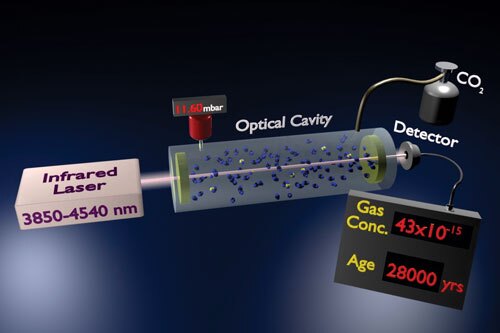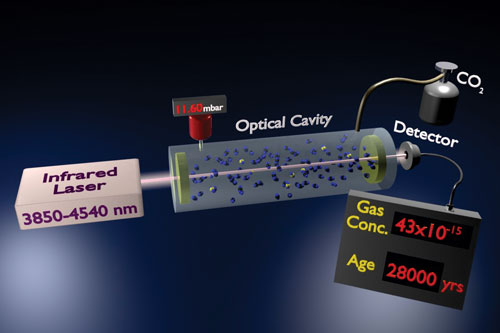A new suitor in the carbon-14 dating game
DOI: 10.1063/PT.3.1428
A new suitor in the carbon-14 dating game. For more than 50 years, analysis of tiny amounts of radioactive 14C has served for dating organic matter. Now Pablo Cancio Pastor and colleagues at Italy’s National Institute of Optics-CNR and European Laboratory for Non-Linear Spectroscopy have developed a new method for measuring minute quantities of that isotope. Their method of saturated-absorption cavity ring-down spectroscopy (SCAR) is not as sensitive as the standard bearer for 14C sensitivity, accelerator mass spectrometry. But whereas AMS needs a dedicated facility, SCAR fits on a lab bench and is less expensive. As shown in the figure, an optical cavity filled with carbon dioxide is illuminated with an intense continuous wave laser tuned to excite a particular molecular transition in 14CO2. When the laser is turned off, the cavity intensity decays both from absorption by the 14CO2 and because light leaks from the cavity. Because the bright light overwhelms (saturates) the ability of the 14CO2 to absorb it, the initial instants of decay are due to leakage. Once that effect is isolated, the researchers can determine how much of the decay is due to molecular absorption and thus determine the quantity of 14CO2. The Italian team reports a 14CO2/12CO2 sensitivity of 4.3 × 10−14, an order of magnitude shy of challenging AMS. Nonetheless, says Cancio Pastor, SCAR is already developed enough for less-demanding biomedical applications. (I. Galli et al., Phys. Rev. Lett. 107, 270802, 2011.)


